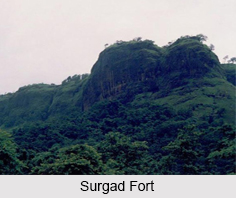 Surgad Fort is a hill fort located in the north-east of the Roha taluka in the Raigad district of Maharashtra. Located in a spur fragmented from the Sahyadri ranges, this fort was an observation fort, which guarded the trade route along the Kundalika River from Sudhagad to Revdanda Fort. Most of the buildings on the fort are in ruined state. The fort is covered by tall grass during September–November. From atop the fort one can have a beautiful view of the Kundalika River.
Surgad Fort is a hill fort located in the north-east of the Roha taluka in the Raigad district of Maharashtra. Located in a spur fragmented from the Sahyadri ranges, this fort was an observation fort, which guarded the trade route along the Kundalika River from Sudhagad to Revdanda Fort. Most of the buildings on the fort are in ruined state. The fort is covered by tall grass during September–November. From atop the fort one can have a beautiful view of the Kundalika River.
History of Surgad Fort
Surgad Fort was built by the Shilahara kings and later the Nizam of Ahmednagar used this fort. The great Maratha king Chhatrapati Shivaji reconstructed this fort. During the Rajaram"s regime, Shankarji Narayan captured this fort from the Siddhi of Janjira. In 1733, Bajirao first captured Surgad. During Peshwa period prisoners were kept in this fort. In the Third Anglo-Maratha War, along with other forts in the neighbouring region Colonel Prother won this fort from the Peshwas in February 1818.
Inscription on the fort suggested that the fort was built in the beginning of the second year of the command of Sidhi Saheb. The architect was Nuryaji and the Governor of the fort was Tukoji Haibat. It seems that the fort was built at times when use of artillery was not known in battle.
Structure of Surgad Fort
Surgad Fort has 17 rock-cut cisterns and a small temple of the Veer Maruti. The main gate of the fort is not in good condition. One cannon is found on the plateau at the base of the fort. There are two good bastions, one at the northern end and the other at the southern end. Two dilapidated buildings namely "Sadar" and "Daru-Kothar" and a temple of Ansai Devi are there near the base of the fort.
Visiting Information of Surgad Fort
From Pune and Mumbai there are State Transport buses are available to Pen. From Pen through local transport one can reach to Khamb village. The nearest railway station is Kolad. It takes about 1 hr to reach the top of the fort. The path passes through wooded forest and not used by local villagers occasionally.




